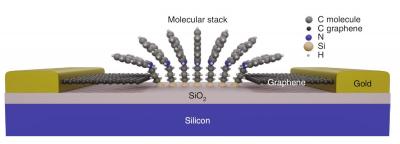A research team jointly led by University of Warwick and EMPA has tackled a challenging issue of stability and reproducibility in working with graphene, that meant that graphene-based junctions were either mechanically stable or electrically stable but not both at the same time.
 Credit: University of Warwick
Credit: University of Warwick
Graphene and graphene like molecules are attractive choices for electronic components in molecular devices, but have proven very challenging to use in large scale production of molecular devices that will work and be robust at room temperatures. The joint research team from the University of Warwick, EMPA and Lancaster and Bern Universities has reached both electrical and mechanical stability in graphene-based junctions.
They produced an electrically effective structure by building a graphene-like molecule stack to form an electron path through the graphene-like molecules P orbitals (dumbbell shaped electron clouds within which an electron can be found, with a certain degree of probability) This would open new avenues to use fascinating molecular properties such as quantum interference which occurs at such a small scale provided a sufficiently mechanical robust structures achieved. For this, the research team also created bonds between each molecule and a silicon-oxide substrate. This gave the structure significant mechanical stability by effectively anchoring the graphene-like molecule stack to the substrate using a silanization reaction.
Dr. Hatef Sadeghi from the University of Warwick's School of Engineering who led the theoretical modelling of this work said: "This method allowed us to design and produce graphene-based molecular devices that are electronically and mechanically stable over a large temperature range. This was achieved by decoupling the mechanical anchoring from the electronic pathways by combining a covalent binding of the molecules to the substrate and large Ï-conjugated head groups... The junctions were reproducible over several devices and operated from 20 Kelvin up to room temperature. Our approach represents a simple but powerful strategy for the future integration of molecule-based functions into stable and controllable nanoelectronic devices."

